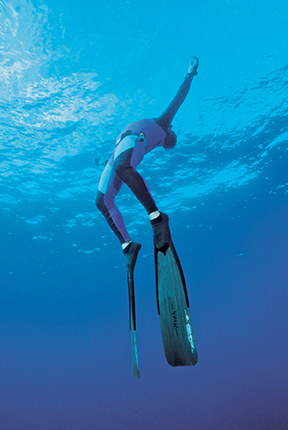Breathe, dive, equalize, ascend, clear, repeat.
If anyone has ever dived without a tank, then you know this
process all too well. Freediving is an
activity and alternative to SCUBA diving that isn’t as equipment
intensive. Of course, you can’t stay
under water as long as a SCUBA diver, but Freediving is fun and rewarding.

Equipped with only a snorkel, fins, and mask (spear gun
optional), a freediver’s objective is to continuously rest at the surface, take
a big deep breath, dive, descend in the water column, equalize the pressure in
your ears as you go down, swim around for a bit, ascend, and clear your snorkel
all while still holding your one breath.
Doing this exercise increases your lung capacity and you only get better
as you practice. It’s a fun way to
experience the underwater world similarly to a SCUBA diver, but you don’t have
to worry about all that equipment; nevertheless, there are some dangers such as
Shallow Water Blackout, a process in
which a freediver loses consciousness while submerged from exceeding their time
that their breath allows them underwater.
This can happen to experienced swimmers and divers alike, but remember
you should always dive with a buddy and both should always keep an eye on the
other.
 |
| This chest-up, ragdoll position is a common sign that somebody is experiencing shallow water blackout |
There are some amazing feats completed by freedivers. Of course, due to competitive nature, there
are different categories and regulations for this activity at the competitive nature
such as with/without fins with/without weights, with fins/without weights etc. The current record depth achieved by a
freediver is held by Herbert Nitsch at an astounding 830 ft. below the
surface. At the same time, Freediving
expert and author James Nestor believes humanity will accomplish a 1000 ft.
freedive soon! It’s a daunting activity
but it has been a part of humanity’s adventurous history and led to the
implementation of the SCUBA.
A fun historical aside involves the story of pearl oyster
diving where people from Asia, India, and Mexico were forced to dive up to 100 ft.
on a single breath in order to hunt pearl oysters on the bottom of the sea
floor. Of course, labor regulations were
like the Wild West in these days before the 20th century, so
employers didn’t give a rat’s hat about their employees being exposed to the
dangers like SWB, the bends, or even drowning.
For more information about this activity, check out James Nestor’s book Deep about freediving or just google it
since I’m too lazy to help you out.
Free diving is so interesting. I cant imagine all the training that goes into it. I think it's also amazing how our bodies adapt to the pressure. 830 ft is crazy!!!
ReplyDelete